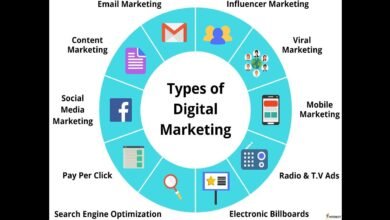How To Create a Digital Marketing Strategy?
Digital Domination-Crafting a Winning Strategy for Online Success

In today’s digital age, having a robust digital marketing strategy is ”How To Create a Digital Marketing Strategy?” crucial for businesses of all sizes. Whether you’re a small startup or a large corporation, effectively reaching and engaging with your target audience online can significantly impact your success. In this comprehensive guide, we’ll delve into the essential steps to create digital marketing that drives results.
Introduction to Digital Marketing Strategy
The “Introduction to Digital Marketing Strategy” serves as a pivotal cornerstone for businesses navigating the online realm, outlining a strategic framework to effectively connect and resonate with their target audience in the digital sphere. This strategic blueprint encompasses an array of digital channels and tactics, meticulously orchestrated to achieve specific marketing objectives and drive tangible business outcomes. It entails meticulous planning, execution, and iterative refinement to leverage the dynamic landscape of digital platforms, fostering brand visibility, customer engagement, and sustainable growth in the digital era.

What is a digital marketing strategy?
A digital marketing strategy outlines how a business will use various digital channels to achieve its marketing objectives. It encompasses everything from website optimization to social media marketing, content creation, email campaigns, and more.
Importance of having a digital marketing strategy
A well-defined digital marketing strategy provides a roadmap for reaching and engaging with your target audience effectively. It helps businesses align their marketing efforts with their overall goals, leading to improved brand visibility, customer engagement, and ultimately, increased revenue.
Understanding Your Target Audience
Understanding Your Target Audience” involves delving deep into the demographics, psychographics, and behaviours of your ideal customers to gain comprehensive ”How To Create a Digital Marketing Strategy?” insights into their preferences, needs, and pain points. This process enables efforts effectively, ensuring that their messages resonate with the right audience segments, driving meaningful engagement and fostering long-term customer relationships.

Identifying your target audience
Before diving into creating a digital marketing strategy, it’s essential to clearly define your target audience. Who are your ideal customers? What are their demographics, interests, and pain points? Understanding your audience will guide your marketing efforts and ensure that your messages resonate with the right people.
Understanding their needs and preferences
Once you’ve identified your target audience, take the time to understand their needs, preferences, and online behaviour. What are they searching for online? Which social media platforms do they frequent? By gaining insights into your audience’s preferences, you can tailor your digital marketing strategy to effectively reach and engage with them.
Setting SMART Goals
Setting SMART Goals” involves establishing objectives that are Specific, Measurable, Achievable, Relevant, and Time-bound. This strategic approach ensures that goals are clearly defined, quantifiable, realistic, aligned with ”How To Create a Digital Marketing and have specific deadlines for achievement, facilitating effective planning and execution.

Specific
When setting goals for your digital marketing strategy, ensure that they are specific and clearly defined. Instead of a vague objective like “increase website traffic,” a specific goal would be “increase organic website traffic by 20% within six months.”
Measurable
Your goals should be measurable so that you can track your progress and determine the success of your digital marketing efforts. Use key performance indicators (KPIs) such as website traffic, conversion rates, and social media engagement to measure your results.
Achievable
While it’s essential to set ambitious goals, they should also be achievable within a realistic timeframe. Consider your resources and capabilities when setting your goals to ensure that they are attainable.
Relevant
Make sure that your goals are relevant to your overall business objectives. Your digital marketing efforts should align with your company’s mission and vision to drive meaningful results.
Time-bound
Set deadlines for achieving your goals to create a sense of urgency and accountability. Having a timeframe will help you stay focused and motivated to work towards achieving your objectives.
Conducting Market Research
Conducting Market Research” entails the systematic gathering, analysis, and interpretation of data related to target markets, industry trends, and consumer behaviour. This process involves employing various research methodologies, such as surveys, interviews, and data analysis tools, to gain market insights ”How To Create a Digital Marketing Strategy?” dynamics, competitive landscapes, and customer preferences. By understanding market trends and consumer needs, businesses can make informed decisions, identify growth opportunities, and develop effective marketing strategies.

Analyzing competitors
Before finalizing your digital marketing strategy, conduct thorough research on your competitors. Analyze their online presence, marketing tactics, and target audience to identify opportunities and gaps that you can leverage.
Identifying trends in the industry
Stay abreast of the latest trends and developments in your industry to ensure that your digital marketing strategy remains relevant and effective. This could include emerging technologies, changes in consumer behaviour, or shifts in market dynamics.
Choosing the Right Digital Marketing Channels
Choosing the Right Digital Marketing Channels” entails a strategic evaluation of available online platforms and channels to identify those ”How To Create a Digital Marketing Strategy?” that are most conducive to reaching and engaging with the target audience effectively. This involves analyzing factors such as audience demographics, platform demographics, platform features, and the alignment of channel capabilities with specific marketing goals. By selecting the most appropriate channels, businesses can optimize their digital marketing efforts and maximize their impact on the desired audience.

Social media marketing
Social media platforms offer a powerful way to connect with your audience, build brand awareness, and drive engagement. Choose the platforms that are most relevant to your target audience and tailor your content to each platform’s unique characteristics.
Content marketing
Content is at the heart of any successful digital marketing strategy. Create high-quality, valuable content that addresses your audience’s needs and interests. This could include blog posts, videos, infographics, and more.
Email marketing
Email marketing remains one of the most effective ways to nurture leads and drive conversions. Build an email list of subscribers and send targeted, personalized emails to engage with your audience and promote your products or services.
SEO (Search Engine Optimization)
Optimizing your website for search engines is crucial for ensuring that your business is discoverable online. Conduct keyword research, optimize your website’s content and structure, and build quality backlinks to improve your search engine rankings.

PPC (Pay-Per-Click) advertising
PPC advertising allows you to target specific keywords and demographics to reach your ideal audience. Set a budget for your PPC campaigns and track their performance to maximize your ROI.
Creating Engaging Content
Creating Engaging Content” involves developing compelling and relevant materials, such as articles, videos, infographics, and social media posts, that captivate and resonate with the target audience. This process includes understanding audience preferences, addressing their needs, and employing creative storytelling techniques to evoke emotion and encourage interaction, ultimately driving meaningful engagement and fostering brand loyalty.
Importance of content in digital marketing
Compelling content is essential for capturing the attention of your audience and driving engagement. Whether it’s blog posts, social media updates, or videos, ensure that your content is relevant, informative, and visually appealing.
Tips for creating engaging content
- Know your audience and tailor your content to their interests and preferences.
- Use captivating headlines and visuals to grab attention.
- Provide valuable information that solves your audience’s problems or addresses their needs.
- Incorporate storytelling to make your content more relatable and memorable.
Implementing SEO Strategies
Implementing SEO Strategies” involves optimizing various aspects of a website to improve its visibility and ranking in search engine results pages. This includes on-page optimization, such as optimizing meta tags and content, as well as off-page optimization, such as building quality backlinks. Effective SEO strategies also involve keyword research and analysis, content optimization, and ongoing monitoring and adjustment to improve organic search performance and drive targeted traffic to the website.

On-page SEO
Optimize your website’s on-page elements such as meta titles, descriptions, headings, and URL structures to improve its visibility in search engine results.
Off-page SEO
Build quality backlinks from reputable websites to increase your website’s authority and improve its search engine rankings.
Keyword research and optimization
Identify relevant keywords related to your business and target audience, and strategically incorporate them into your website’s content to improve its visibility in search engine results.
Leveraging Social Media
Leveraging Social Media” involves strategically utilizing various social media platforms to build brand awareness, engage with the target audience, and drive meaningful interactions. This includes creating compelling content, fostering community engagement, responding to comments and messages promptly, and leveraging social media advertising to reach specific audience segments. Effective social media leveraging can lead to increased brand visibility, customer engagement, and ultimately, business growth.
Building a strong social media presence
Create a consistent brand presence across your social media platforms and actively engage with your audience by sharing valuable content, responding to comments, and participating in conversations.
Engaging with your audience
Encourage two-way communication with your audience by asking questions, soliciting feedback, and responding to comments and messages promptly.
Measuring and Analyzing Results
Measuring and Analyzing Results” involves systematically evaluating the performance of. Digital marketing efforts using key performance indicators (KPIs) and analytics tools. This includes tracking metrics such ”How To Create a Digital Marketing Strategy?” as website traffic. Conversion rates, social media engagement, and ROI to assess the effectiveness of marketing campaigns. Analyzing results enables businesses to identify areas for improvement, optimize strategies, and make data-driven decisions to achieve their marketing goals.

Key metrics to track
Monitor key performance indicators (KPIs) such as website traffic, and conversion rates. Social media engagement, email open rates, and ROI to measure the effectiveness of your digital marketing efforts.
Tools for measuring digital marketing performance
Utilize analytics tools such as Google Analytics, social media insights, and email marketing. Platforms to track and analyze your marketing performance.
Adjusting and Improving Your Strategy
Adjusting and Improving Your Strategy” encompasses the ongoing process of assessing. The efficacy of your digital marketing approach and making iterative ”How To Create a Digital Marketing Strategy?” refinements to enhance performance. This involves analyzing data, monitoring market trends, and soliciting feedback to identify areas for optimization and adaptation. By embracing a dynamic and responsive approach. Businesses can iteratively enhance their strategies to better align with evolving consumer behaviours and market conditions. Ultimately driving sustained success.
Continuous optimization based on data
Regularly review your digital marketing performance data and make data-driven adjustments to optimize your strategy for better results.
Adapting to changes in the market
Stay agile and flexible in your approach to digital marketing, and be prepared to adapt. Your strategy is in response to changes in the market, industry trends, or consumer behaviour.
Conclusion
In conclusion, creating a successful digital marketing strategy requires careful planning, research, and execution. By understanding ”How To Create a Digital Marketing Strategy?” your target audience, setting SMART goals, choosing the right digital marketing channels, and creating engaging content. Implementing SEO strategies, leveraging social media, and continuously measuring and analyzing results. You can develop a strategy that drives meaningful results for your business.

FAQs
How often should a digital marketing strategy be reviewed and updated?
Digital marketing strategies should be reviewed and updated regularly to ensure that they remain relevant and effective. Depending on your business goals and industry dynamics, this could range from quarterly reviews to annual updates.
Is it necessary to hire a professional to create a digital marketing strategy?
While some businesses may choose to hire professionals such as digital marketing agencies or consultants to develop their strategies. It's also possible for businesses to create effective strategies in-house. The key is to have a solid understanding of digital marketing principles and to dedicate. The necessary time and resources to strategy development and execution.







